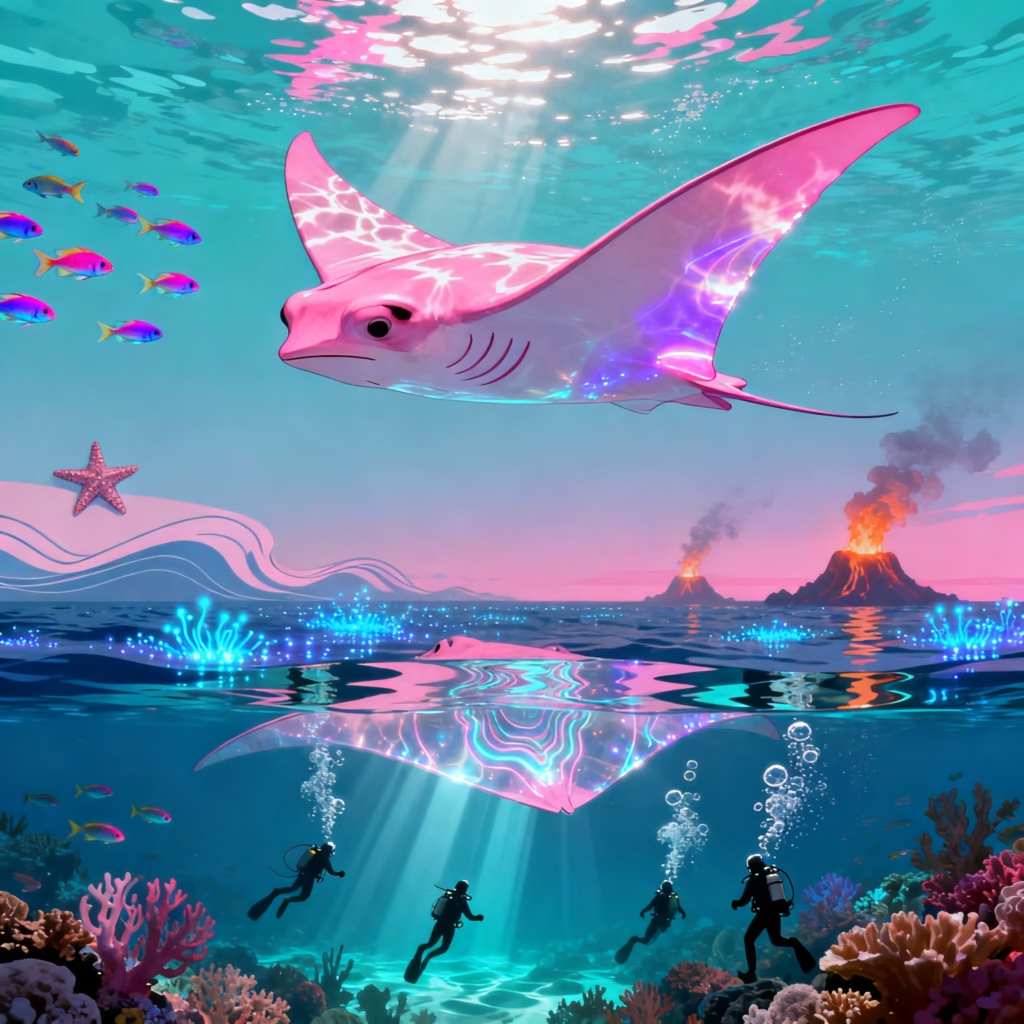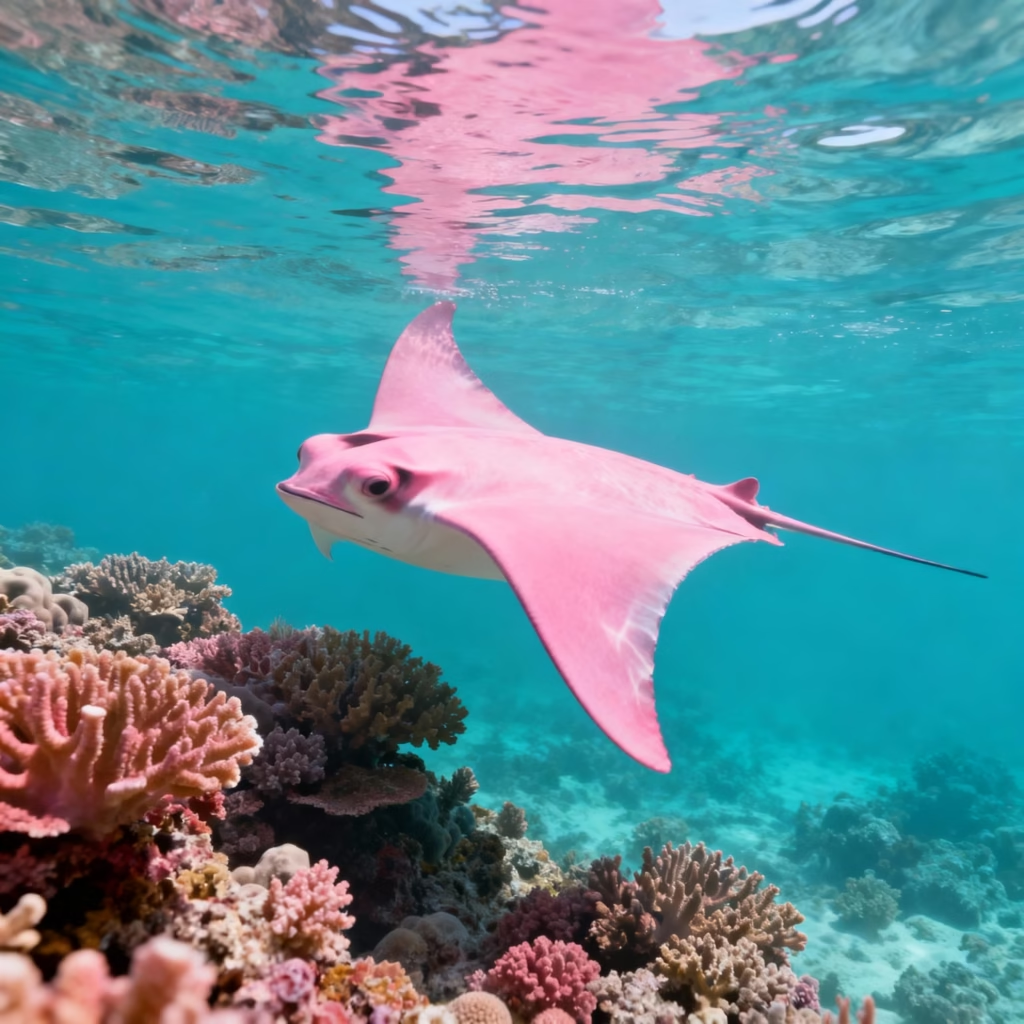The Ocean’s Unicorn: Discover the World’s Only Pink Manta Ray
In the vast, mysterious world beneath the ocean’s surface, nature never ceases to astonish us. Just when we assume that humans have mapped every reef, cataloged every aquatic species, and uncovered every corner of marine life, the ocean reveals another secret — something so rare and magical that it leaves scientists and divers in awe. One such phenomenon is the pink manta ray, affectionately named Inspector Clouseau, the only known manta ray of its kind on Earth. Often called the “unicorn of the ocean,” this extraordinary creature is a living symbol of how much of our planet still remains unexplored and full of wonder.
Nature’s Endless Surprises Beneath the Waves
The natural world has a remarkable way of humbling humanity. Despite centuries of scientific discovery, technological progress, and underwater exploration, many aspects of Earth’s biodiversity continue to surprise us. Scientists estimate that over 80% of our oceans are still unexplored. Within that enormous expanse lies countless species waiting to be discovered, many of them exhibiting colors, behaviors, and characteristics that defy current scientific explanations.
From deep-sea fish that glow in total darkness to coral reefs that shimmer with psychedelic hues, the marine world constantly challenges our understanding of evolution and adaptation. But sometimes, the most fascinating discoveries don’t come from the depths of the Mariana Trench or Antarctica’s icy waters — they appear in familiar places like Australia’s Great Barrier Reef, one of the most studied and frequently visited marine ecosystems in the world. This is precisely where the incredible pink manta ray first appeared, stunning divers and researchers alike.
The Discovery of Inspector Clouseau — The Pink Manta Ray
The pink manta ray, known among marine enthusiasts as Inspector Clouseau, owes its playful nickname to the beloved detective from The Pink Panther franchise. This extraordinary male manta ray was first sighted in 2015 near Lady Elliot Island, a coral cay located at the southernmost end of the Great Barrier Reef. At approximately 11 feet across, he is not only enormous but also uniquely colored — a vibrant, bubblegum pink that instantly distinguishes him from all other manta rays on the planet.
Since that first encounter, this rare creature has been seen only around ten times, despite dwelling in one of the world’s most popular diving destinations. His limited visibility adds to his allure, making each sighting a special event for divers lucky enough to witness him gliding gracefully through the water. For many, spotting Inspector Clouseau feels like witnessing a myth come to life.

The Mystery Behind the Pink Hue
The question that puzzled marine biologists for years was simple yet fascinating: how did a manta ray, typically black, white, or gray, get such a striking shade of pink?
Initially, researchers theorized that the pinkish tint could be the result of the ray’s diet, similar to flamingos that turn pink from consuming carotenoid-rich crustaceans. However, this idea was quickly dismissed through a 2016 study conducted by Project Manta, a scientific group dedicated to studying manta rays across Australia.
Upon careful observation and tissue analysis, scientists concluded that the coloration was likely due to a genetic mutation, rather than an environmental factor like diet or exposure. This mutation alters the pigmentation in the skin cells, producing the distinctive rosy hue that sets this manta apart from every other known specimen.
Could There Be More Pink Manta Rays?
The big question on everyone’s mind is whether this pink color is a one-time fluke of nature or a heritable trait. If the genetic mutation is indeed capable of being passed down and Inspector Clouseau successfully mates with a female, there lies a possibility—however slim—that more pink manta rays may appear in the future.
Researchers have observed that this rare individual isn’t a recluse. In fact, he regularly interacts with other male manta rays, often competing for female attention, much like his monochrome counterparts. Whether his unique color gives him an advantage or makes him less appealing during mating displays is still under study, but either way, his existence proves the ocean’s capacity for evolutionary surprises.
A Symbol of Hope Amid Global Marine Challenges
In an age where environmental concerns dominate scientific discussions, the pink manta ray represents more than just a biological curiosity. He stands as a symbol of nature’s resilience and capacity for wonder, even as human activities threaten marine ecosystems worldwide.
With coral bleaching events, rising sea temperatures, pollution, and overfishing affecting aquatic biodiversity, stories like that of Inspector Clouseau remind us that there is still time — and reason — to protect our oceans. Each discovery rekindles global interest in conservation and renews efforts to safeguard endangered habitats from further damage.
The manta ray population, while not critically endangered, is facing increasing pressure from fishing and habitat loss. The presence of such a unique specimen emphasizes not only the beauty of marine life but also the importance of preserving it for future generations.
The Great Barrier Reef — A Natural Wonder and Home to the Pink Manta
Lady Elliot Island, where Inspector Clouseau was discovered, is often described as the “home of the manta ray.” Located within Australia’s Great Barrier Reef Marine Park, the island is world-famous for its crystal-clear waters, rich biodiversity, and coral gardens teeming with life. It is one of the best places in the world for snorkeling and scuba diving, offering encounters with sea turtles, reef sharks, and, on rare occasions, the elusive pink manta.
Diving conditions are ideal all year round, and because the island operates under strict eco-tourism regulations, its waters remain pristine. Many divers travel specifically to witness the migration of giant manta rays between May and August. For those lucky enough to see the pink manta during those months, it becomes the highlight of a lifetime.
Where Else Can You Spot Manta Rays Around the World?
If the pink manta ray has sparked your fascination, there are several stunning destinations around the world where you can swim alongside these graceful giants:
-
Socorro Island, Mexico: Known as the “Galápagos of Mexico,” Socorro offers breathtaking encounters with oceanic manta rays in their natural environment.
-
Palau: This Pacific paradise features vibrant coral reefs where manta rays congregate during plankton blooms.
-
Fiji: With its clear tropical waters and abundance of marine life, Fiji is a hot spot for manta enthusiasts.
-
The Maldives: Famous for manta cleaning stations like Hanifaru Bay, where hundreds of rays gather during feeding season.
-
Raja Ampat, Indonesia: Often cited as the most biodiverse marine region on Earth, Raja Ampat is home to both reef and giant manta species.
-
Ishigaki Island, Japan: A popular diving destination where manta rays are commonly sighted near coral-covered rock formations.
-
The Bahamas and Cayman Islands: In addition to manta encounters, visitors can swim with gentle stingrays in shallow, sunlit waters.
Each of these destinations showcases manta rays in different forms and habitats, giving divers a chance to connect with some of the ocean’s most intelligent and curious creatures.

The Behavior and Biology of Manta Rays
Manta rays are among the largest fish in the ocean, with wingspans that can reach up to 23 feet in giant species. Despite their size, they are gentle plankton feeders, filtering microscopic organisms from the water as they gracefully swim. Their intelligence is remarkable, with studies showing that mantas are capable of recognizing themselves in mirrors — a sign of advanced cognitive ability shared by only a handful of species, including dolphins and great apes.
Unlike sharks, their close relatives, manta rays possess no dangerous teeth or stingers. They are harmless to humans and often exhibit curiosity toward divers, sometimes circling them repeatedly in what seems like playful interaction. These behaviors make swimming with manta rays a transcendent experience for underwater adventurers around the globe.
Conservation: Protecting the Future of Manta Rays
While manta rays inspire awe wherever they’re found, their populations face several conservation challenges. Overfishing for gill plates, which are used in traditional medicine markets, continues to threaten their survival. Moreover, climate change and ocean acidification have disrupted coral reef ecosystems, leading to reduced plankton levels — a primary food source for mantas.
Organizations like Project Manta, Manta Trust, and the Marine Megafauna Foundation are actively studying these creatures to promote sustainable conservation efforts. By tagging and tracking mantas using satellite technology, scientists gather invaluable data on migration patterns, genetic diversity, and breeding behavior.
Supporting sustainable tourism, enforcing fishing bans in manta-rich zones, and raising awareness about ocean pollution play critical roles in ensuring these majestic creatures thrive for generations to come.
What the Pink Manta Ray Teaches Humanity
Beyond its biological significance, Inspector Clouseau embodies a deeper narrative — one about rediscovering wonder in a world where mystery often feels scarce. At a time when headlines are dominated by environmental decline, deforestation, and extinction, the story of the pink manta reminds us that hope glimmers even in the depths of the sea.
The rarity of this pink manta ray urges humans to protect what still exists. It encourages us to treat the ocean not as an endless resource to exploit, but as a living, breathing entity deserving of care and respect. Just as the pink flamingo became a symbol of beauty and adaptation, Inspector Clouseau represents uniqueness, resilience, and the enchanting unpredictability of nature.

Conclusion: The Call of the Ocean’s Unicorn
In the end, the story of the pink manta ray is more than a beautiful marine mystery — it’s a reflection of how extraordinary the natural world continues to be. As humanity advances technologically, we must remember that there is still so much to learn, protect, and appreciate. One single creature — glowing pink beneath the turquoise waters of the Great Barrier Reef — reminds us that nature holds infinite stories, waiting patiently for us to rediscover them.
So, if ever you dive off the coast of Lady Elliot Island, keep your eyes open. You might just glimpse Inspector Clouseau, the ocean’s unicorn — a rare, breathtaking reminder that our world still dances with magic, even in its quietest depths.
for interesting articles, visit BULLETINBUZZS
